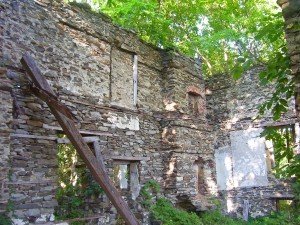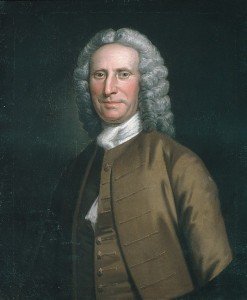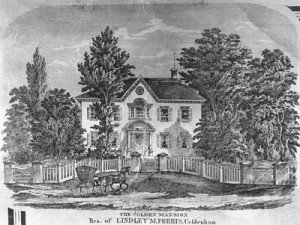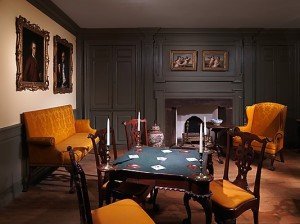 Just about any morning, cars as well as trucks race back and forth through the intersection of Stone Castle Road and Route 17K in the Town of Montgomery. Many of these commuters, shoppers, or moms driving their children to school are oblivious to the ruins that stand right off to the side, in a wood lot, of the rather busy part of this Orange County road.
Just about any morning, cars as well as trucks race back and forth through the intersection of Stone Castle Road and Route 17K in the Town of Montgomery. Many of these commuters, shoppers, or moms driving their children to school are oblivious to the ruins that stand right off to the side, in a wood lot, of the rather busy part of this Orange County road.
Only while stopping along the road, some years ago, I happened upon the remains of what seemed to have once been a beautiful mansion. A blue New York State Education Department sign alerts people that this skeleton, almost lost in the woods, was the site of “the Colden Mansion built of stone in 1767 by Cadwallader Colden, Jr.” How many families, like the Coldens, can boast about having Royal Surveyors, Lieutenant Governors, Acting Governors of New York, noted scientists, and even one of the first female botanists in the Americas among them?
 The Colden’s played an integral part in both local and state history, beginning locally when Cadwallader Colden Sr. was the first Colden to come to the area that would become Coldenham in 1727. He was granted three thousand acres of land. It was his son Cadwallader Colden, Jr., who inherited some five hundred acres of land in 1744 and built a luxurious home on this plot of land. A 1959 article from The Newburgh News described the inside of the mansion: “The house had 17 large rooms, nine open fireplaces with mantels, two bathrooms, a butler’s pantry, three wide halls, and 10 foot ceilings….” The paper went on to note the “grey field stone houses” and interior paneling that had been brought from England, features representing the height of opulence for the area.
The Colden’s played an integral part in both local and state history, beginning locally when Cadwallader Colden Sr. was the first Colden to come to the area that would become Coldenham in 1727. He was granted three thousand acres of land. It was his son Cadwallader Colden, Jr., who inherited some five hundred acres of land in 1744 and built a luxurious home on this plot of land. A 1959 article from The Newburgh News described the inside of the mansion: “The house had 17 large rooms, nine open fireplaces with mantels, two bathrooms, a butler’s pantry, three wide halls, and 10 foot ceilings….” The paper went on to note the “grey field stone houses” and interior paneling that had been brought from England, features representing the height of opulence for the area.
Fortune changed for the Coldens before and during the American Revolution. In 1765, while Colden Sr. was acting Governor of the Province of New York, his carriage was destroyed by a mob protesting the Stamp Act. Later, his son refused to sign the oath of allegiance and was arrested several times before requesting he be allowed to go to New York City, where he believed he would be safer. In 1776, his father died in Flushing, Queens and was thus spared the worst that the Revolution had to offer the family.
 The Colden’s mansion passed out of the family by the 1890s. According to the same article in The Newburgh News, by the 1930s, George Bache had purchased the home by way of back taxes owed on the house and property the previous owners. Bache realized the importance of the site and hoped to sell it to the New-York Historical Society, a plan that fell through.
The Colden’s mansion passed out of the family by the 1890s. According to the same article in The Newburgh News, by the 1930s, George Bache had purchased the home by way of back taxes owed on the house and property the previous owners. Bache realized the importance of the site and hoped to sell it to the New-York Historical Society, a plan that fell through.
The home’s disrepair was reported periodically in local newspapers. In the 1940s, all of the windows were broken and missing, the rooms vandalized, and anything of value stolen. During this time, according to The Newburgh News, some of its unique paneling from the parlor was removed to the Metropolitan Museum of Art in New York City. By 1959 the mansion belonged to the Affron family, who had purchased the house and property with the hope of restoring it. They found the costs involved staggering and the home entered into a period of extended deterioration.
By the 1970s, what was still standing of the home was consider ready for the wrecking ball, but was ignored until 1997, when the Town of Montgomery gave the site landmark status. By then, only a few outside walls remained and its original 3,000 acres had been whittled down to eight.
 The site was added to the National register of Historic Places in 2007 and in 2010, a group of local historians and activists came together to raise awareness of the ruins of what was once the home of one of the richest and most influential families in New York. The group named itself The Coldengham Preservation and Historical Society. Their mission is to raise awareness and appreciation of the history and legacy of Cadwallader Colden, and the Colden family, and to develop a heritage park encompassing the mansion ruins, Colden Family Cemetery and Colden Canal. The organization also hopes to build an interpretive center which would also bring to light the long held interest of the Colden family in the natural history world (their remains an abundance of flora and fauna on the grounds).
The site was added to the National register of Historic Places in 2007 and in 2010, a group of local historians and activists came together to raise awareness of the ruins of what was once the home of one of the richest and most influential families in New York. The group named itself The Coldengham Preservation and Historical Society. Their mission is to raise awareness and appreciation of the history and legacy of Cadwallader Colden, and the Colden family, and to develop a heritage park encompassing the mansion ruins, Colden Family Cemetery and Colden Canal. The organization also hopes to build an interpretive center which would also bring to light the long held interest of the Colden family in the natural history world (their remains an abundance of flora and fauna on the grounds).
This year, the society will host its first ever Colden Day in an effort to raise local awareness of the site. Local historians will give tours and explain the site to visitors. It’s hoped this will become an annual event. Even though the original mansion can never be replaced, there are lessons to be learned from the site, including what happens when historical treasures are allowed to fall into decline.
Illustrations: From above, the mansion ruins today- a Cadwallader Colden portrait by John Wollaston (active 1733–67- painted 1749–52), from the collections of the Metropolitan Museum of Art, a bequest of Grace Wilkes, 1922- the mansion as it looked in the late 19th century- and circa 1767 pine woodwork from the Colden House on display at the Metropolitan Museum of Art (Purchase, The Sylmaris Collection, Gift of George Coe Graves, by exchange, 1940).
Queens College (CUNY) has a “Colden Cente auditorium”. Do you know if the Coldens of the article are related in any way to the Colden who gave his (her?) name to the facility at Queens College?
It is important to include Jane Colden when mentioning the Colden family. Jane is considered the “first botanist of her sex in her country”. There is a wonderful blog about her on “Women in the Garden”:
http://womenandthegarden.blogspot.com/2011/03/jane-colden-botanist-new-york.html